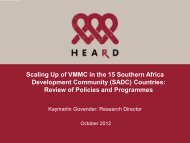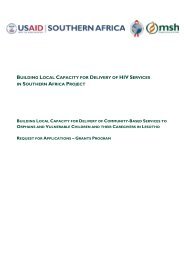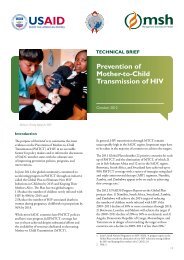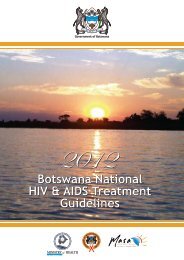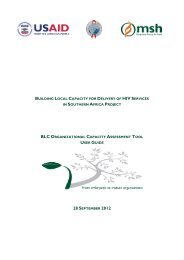Mutual Fidelity
Mutual Fidelity
Mutual Fidelity
Create successful ePaper yourself
Turn your PDF publications into a flip-book with our unique Google optimized e-Paper software.
mutual<br />
fidelity<br />
first<br />
© INERELA 2012<br />
first edition
Session Objectives<br />
Session Overview<br />
Key Message<br />
Present mutual fidelity as a SAFE sexual practice<br />
Discussions<br />
You have sex with every single person with whom your partner has<br />
sex<br />
Expected Learning Outcomes Understanding that each person has a sexual history<br />
Having one partner – whose status is known – is important in<br />
preventing HIV transmission<br />
Serial monogamy is not mutual fidelity<br />
Toolkit References<br />
Time<br />
Materials needed:<br />
<strong>Mutual</strong><br />
fidelity<br />
VCT<br />
Condoms<br />
© INERELA 2012<br />
30 minutes<br />
Flipchart and markers<br />
2
Activity:<br />
Insert a play on mutual fidelity – something funny but giving the message<br />
that monogamy is good for people not just because it prevents<br />
HIV transmission but because it provides a good environment for a<br />
couple to grow. Furthermore, the message needs to be conveyed that<br />
you have sex with every other partner with whom your partner has<br />
had sex – so get tested before each new sexual relationship.<br />
Facilitator’s notes:<br />
• zDo not be prescriptive about sex before marriage. Most teenagers have<br />
had some type of sexual experience ranging from foreplay to penetrative<br />
sex. The message that you want to convey is that sex in a positive,<br />
mutually respectful and monogamous relationship is sexually healthy<br />
and responsible. You also want to encourage people to voluntarally have<br />
their HIV status tested as they enter new sexual relationships.<br />
• zWithin some cultural groups polygamy is a culturally acceptable form<br />
of sexual expression. It could, in this context, be appropriate to discuss<br />
some of the ways polygamous relationships can be conducted safely.<br />
• zDiscuss parallel relationships if appropriate. This would involve, for<br />
example, migrant workers who have partners at home and partners in<br />
their places of work. Many people see these relationships as being safe<br />
and exclusive.<br />
© INERELA 2012<br />
3
Level 1: Preventing transmission:<br />
Discussion:<br />
a) Why is it hard to have only one partner?<br />
b) Question: real men have many sexual experiences, real women wait<br />
until they are married. How does this impact on sexual relationships?<br />
Facilitator’s Notes:<br />
This module relies on 100% truthfulness and trust between each partner.<br />
<strong>Mutual</strong> fidelity means that there are only two people in the relationship<br />
and neither are having sexual relations outside of this relationship. Both<br />
people should be tested for STIs and HIV so as if they are engaging in unprotected<br />
sex they know their status and they are not putting their partner<br />
at risk. Most people will have a sexual past. Testing for STIs and HIV is to<br />
insure that the past does not interfere medically with the current relationship.<br />
The time span of the relationship is important; a person can be termed a ‘serial monogamist’.<br />
This means they are in a relationship for a short period of time, during<br />
this time they are faithful, however the relationship does not last long and then they<br />
move on to the next person. Once again testing for STIs and HIV with each person is<br />
important.<br />
For people in a long term monogamous relationship the key is communication. Making<br />
sure you are on the right path and that you are both happy within the relationship.<br />
You have to communicate your feelings rather than seeking comfort in the arms<br />
of someone else.<br />
© INERELA 2012<br />
Doubts of fidelity:<br />
• zIs someone cheating?<br />
• zSeparation<br />
• zTravel expectations<br />
• zMigrant labour<br />
• zLoneliness of being left at home<br />
4
Discussion:<br />
Divide participants into small groups. You may want to further separate<br />
these groups by age and gender.<br />
Talk about ways in which you can talk to your partner about your sex life.<br />
Are they happy with it; are there ways in which they want to change it?<br />
What services are there to support people in long-term relationships?<br />
Level 2: Supporting people living with<br />
HIV:<br />
People can have a very long and fulfilling relationship when one person or both are<br />
HIV positive, the dynamics are the same.<br />
(Having a good relationship with a family doctor is important).<br />
Facilitator’s Notes:<br />
• zPolygamous relationships where one or multiple people have HIV can<br />
also be safe and healthy. However, because there are many sexual partners<br />
in a polygamous relationship, if one person within this relationship<br />
is HIV positive the rest will be vulnerable to HIV transmission.<br />
Furthermore, the person who is HIV positive is made more vulnerable<br />
of reinfection with HIV due to the ability of the virus to mutate rapidly.<br />
Thus SAFER sexual practice should form part of this relationship. It<br />
would be recommended that all the people involved in the polygamous<br />
relationship knew their status and that SAFER sexual practices were<br />
consistent across the whole group.<br />
• zMultiple concurrent partnerships carry a high risk of HIV transmission.<br />
In new sexual relationships, sexual boundaries are often not made clear<br />
at the start. Thus SAFER sexual practice could be adopted in one relationship<br />
but not in another. Unfortunately, this leads to the increased<br />
risk of transmission.<br />
• zSerial monogomy also increases the vulnerability to HIV transmission.<br />
Once again, sexual boundaries can be fluid at the start and end of relationships.<br />
Furthermore, partners may be exclusive for a number of<br />
years before they break-up and develop new relationships. During this<br />
long exclusivity they may have engaged in sexual practices that were<br />
not SAFE. Ensure that before you enter a new relationship you know<br />
your status and that your sexual boundaries include SAFER sexual<br />
practices throughout the relationship.<br />
© INERELA 2012<br />
5
Reflection and Notes<br />
© INERELA 2012<br />
6
Reflection and Notes<br />
© INERELA 2012<br />
7
SAVE<br />
© INERELA 2012<br />
TOOLKIT<br />
A Practical Guide to the SAVE Prevention Methodology



